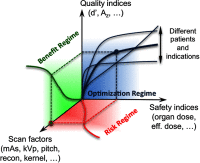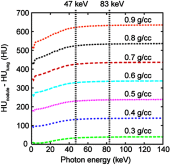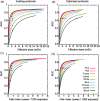Size-based quality-informed framework for quantitative optimization of pediatric CT
- PMID: 28840168
- PMCID: PMC5565677
- DOI: 10.1117/1.JMI.4.3.031209
Size-based quality-informed framework for quantitative optimization of pediatric CT
Abstract
The purpose of this study was to formulate a systematic, evidence-based method to relate quantitative diagnostic performance to radiation dose, enabling a multidimensional system to optimize computed tomography imaging across pediatric populations. Based on two prior foundational studies, radiation dose was assessed in terms of organ doses, effective dose ([Formula: see text]), and risk index for 30 patients within nine color-coded pediatric age-size groups as a function of imaging parameters. The cases, supplemented with added noise and simulated lesions, were assessed in terms of nodule detection accuracy in an observer receiving operating characteristic study. The resulting continuous accuracy-dose relationships were used to optimize individual scan parameters. Before optimization, the nine protocols had a similar [Formula: see text] of [Formula: see text] with accuracy decreasing from 0.89 for the youngest patients to 0.67 for the oldest. After optimization, a consistent target accuracy of 0.83 was established for all patient categories with [Formula: see text] ranging from 1 to 10 mSv. Alternatively, isogradient operating points targeted a consistent ratio of accuracy-per-unit-dose across the patient categories. The developed model can be used to optimize individual scan parameters and provide for consistent diagnostic performance across the broad range of body sizes in children.
Keywords: children; computed tomography; diagnostic accuracy; image quality; lung nodule; pediatric; radiation dose; size-specific protocols.
Figures







Similar articles
-
Estimability index for volume quantification of homogeneous spherical lesions in computed tomography.J Med Imaging (Bellingham). 2018 Jul;5(3):031404. doi: 10.1117/1.JMI.5.3.031404. Epub 2017 Dec 11. J Med Imaging (Bellingham). 2018. PMID: 29250571 Free PMC article.
-
How accurate is size-specific dose estimate in pediatric body CT examinations?Pediatr Radiol. 2016 Aug;46(9):1234-40. doi: 10.1007/s00247-016-3604-0. Epub 2016 Apr 6. Pediatr Radiol. 2016. PMID: 27053280
-
Automatic CT simulation optimization for radiation therapy: A general strategy.Med Phys. 2014 Mar;41(3):031913. doi: 10.1118/1.4866377. Med Phys. 2014. PMID: 24593731
-
Weight-based, low-dose pediatric whole-body PET/CT protocols.J Nucl Med. 2009 Oct;50(10):1570-7. doi: 10.2967/jnumed.109.065912. J Nucl Med. 2009. PMID: 19793734
-
Optimization of beam quality for photon-counting spectral computed tomography in head imaging: simulation study.J Med Imaging (Bellingham). 2015 Oct;2(4):043504. doi: 10.1117/1.JMI.2.4.043504. Epub 2015 Nov 6. J Med Imaging (Bellingham). 2015. PMID: 26835495 Free PMC article.
Cited by
-
Detection of unwarranted CT radiation exposure from patient and imaging protocol meta-data using regularized regression.Eur J Radiol Open. 2019 Jun 5;6:206-211. doi: 10.1016/j.ejro.2019.04.007. eCollection 2019. Eur J Radiol Open. 2019. PMID: 31194104 Free PMC article.
References
LinkOut - more resources
Full Text Sources
Other Literature Sources

